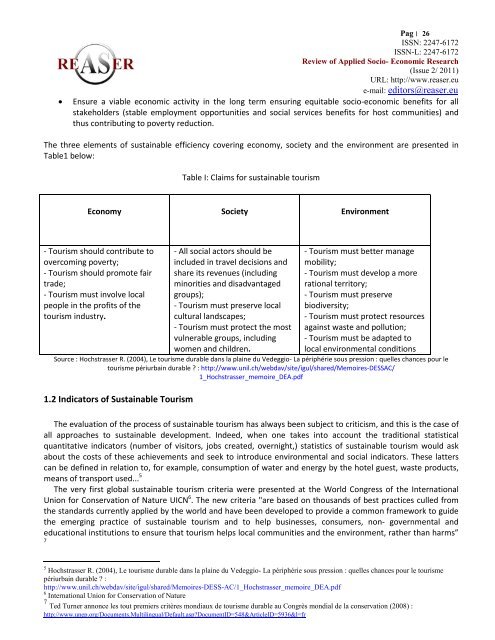Volume 2, ISSUE2/2011 - Review of Applied Socio-Economic ...
Volume 2, ISSUE2/2011 - Review of Applied Socio-Economic ...
Volume 2, ISSUE2/2011 - Review of Applied Socio-Economic ...
You also want an ePaper? Increase the reach of your titles
YUMPU automatically turns print PDFs into web optimized ePapers that Google loves.
Pag׀ 26 ISSN: 2247-6172ISSN-L: 2247-6172<strong>Review</strong> <strong>of</strong> <strong>Applied</strong> <strong>Socio</strong>- <strong>Economic</strong> Research(Issue 2/ <strong>2011</strong>)URL: http://www.reaser.eue-mail: editors@reaser.eu• Ensure a viable economic activity in the long term ensuring equitable socio-economic benefits for allstakeholders (stable employment opportunities and social services benefits for host communities) andthus contributing to poverty reduction.The three elements <strong>of</strong> sustainable efficiency covering economy, society and the environment are presented inTable1 below:Table I: Claims for sustainable tourismEconomy Society Environment- Tourism should contribute toovercoming poverty;- Tourism should promote fairtrade;- Tourism must involve localpeople in the pr<strong>of</strong>its <strong>of</strong> thetourism industry.- All social actors should beincluded in travel decisions andshare its revenues (includingminorities and disadvantagedgroups);- Tourism must preserve localcultural landscapes;- Tourism must protect the mostvulnerable groups, includingwomen and children.- Tourism must better managemobility;- Tourism must develop a morerational territory;- Tourism must preservebiodiversity;- Tourism must protect resourcesagainst waste and pollution;- Tourism must be adapted tolocal environmental conditionsSource : Hochstrasser R. (2004), Le tourisme durable dans la plaine du Vedeggio- La périphérie sous pression : quelles chances pour letourisme périurbain durable ? : http://www.unil.ch/webdav/site/igul/shared/Memoires-DESSAC/1_Hochstrasser_memoire_DEA.pdf1.2 Indicators <strong>of</strong> Sustainable TourismThe evaluation <strong>of</strong> the process <strong>of</strong> sustainable tourism has always been subject to criticism, and this is the case <strong>of</strong>all approaches to sustainable development. Indeed, when one takes into account the traditional statisticalquantitative indicators (number <strong>of</strong> visitors, jobs created, overnight,) statistics <strong>of</strong> sustainable tourism would askabout the costs <strong>of</strong> these achievements and seek to introduce environmental and social indicators. These latterscan be defined in relation to, for example, consumption <strong>of</strong> water and energy by the hotel guest, waste products,means <strong>of</strong> transport used... 5The very first global sustainable tourism criteria were presented at the World Congress <strong>of</strong> the InternationalUnion for Conservation <strong>of</strong> Nature UICN 6 . The new criteria "are based on thousands <strong>of</strong> best practices culled fromthe standards currently applied by the world and have been developed to provide a common framework to guidethe emerging practice <strong>of</strong> sustainable tourism and to help businesses, consumers, non- governmental andeducational institutions to ensure that tourism helps local communities and the environment, rather than harms”75 Hochstrasser R. (2004), Le tourisme durable dans la plaine du Vedeggio- La périphérie sous pression : quelles chances pour le tourismepériurbain durable ? :http://www.unil.ch/webdav/site/igul/shared/Memoires-DESS-AC/1_Hochstrasser_memoire_DEA.pdf6 International Union for Conservation <strong>of</strong> Nature7 Ted Turner annonce les tout premiers critères mondiaux de tourisme durable au Congrès mondial de la conservation (2008) :http://www.unep.org/Documents.Multilingual/Default.asp?DocumentID=548&ArticleID=5936&l=fr








